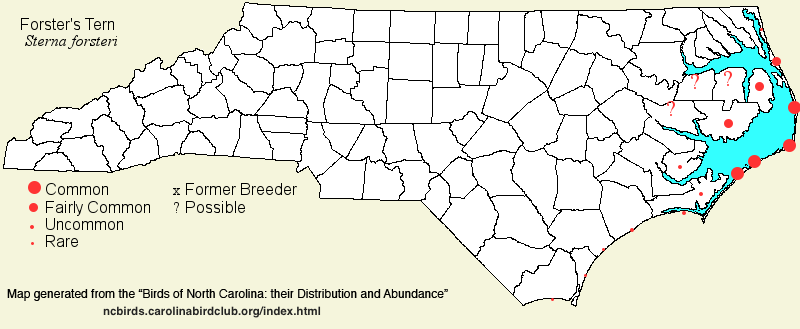 |  |
|
Forster's Tern - Sterna forsteri LARIDAE Members: | Search Common: Search Scientific: |
|
|
|||||||
| General Comments | The Forster's Tern is the only tern that remains relatively common along the coast of North Carolina during the winter months. As it also breeds along much of the coast and in Tidewater areas, it is a permanent resident in these areas, though there are certainly migrant populations, and nobody knows if the birds that breed in the state are the same birds that overwinter. This species, like the Common Tern, also has a substantial breeding population in the interior of the continent, and thus migrants pass over the inland portion of the state and are seen from time to time at the larger lakes and reservoirs. This species has remarkable habitat shifts between summer and winter. In the breeding season, Forster's Terns nest in brackish marshes, mainly around the perimeter of Pamlico Sound, even on the mainland side. For foraging, the species feeds around fresh or brackish pools and ponds, and around the sounds, leaving the oceans and inlets to the Common Tern. However, at other seasons, especially in winter, Forster's Terns have no competition from Common Terns, and thus they forage over the ocean, inlets, and sounds, as well as at pools and ponds. Whether the Common Terns exclude the Forster's from feeding in the ocean is uncertain, but at least in the breeding season these two similar species co-exist by foraging in different habitats. | ||||||
| Breeding Status | Breeder | ||||||
| NC BRC List | Definitive | ||||||
| State Status | W | ||||||
| U.S. Status | |||||||
| State Rank | S3B,S5N | ||||||
| Global Rank | G5 | ||||||
| Coastal Plain | Permanent resident, with migratory movements; primarily coastal. Fairly common breeder around the perimeter of Pamlico Sound; uncommon to fairly common in summer along most of the immediate coastline, but generally uncommon in summer along the southernmost coast. In winter, generally common along the southern half of the coast, and variously uncommon to common northward (though can be scarce in severe weather). In Tidewater, breeds sparingly in tidal marshes, and it is uncommon to locally fairly common elsewhere in summer; at other seasons, it is uncommon to fairly common, though more frequent over brackish water. Farther inland, it is a very rare to rare spring transient and uncommon fall transient, and very rare winter visitor (several records in Dec, but none from Jan to Mar). Peak counts: 3,000, Cape Hatteras Point, 29 Nov 1975; 1,000, Bird Shoal near Beaufort, 22 Sep 1973. | ||||||
| Piedmont | Transient. Rare spring migrant and uncommon fall migrant at larger lakes and reservoirs, occasionally common after hurricanes in fall. Mainly mid-Apr to mid-May, and mid-Jul to early Oct, with scattered records to late Nov. Apparently only five winter records: one at Jordan Lake on 29 Dec 2002; one at Brier Creek Reservoir (Wake) on 7 Feb 1993; one far west at Lake Adger (Polk) on 30 Dec 2020; one at Lake Crabtree (Wake) on 19 Feb 2024; and four at Kerr Lake (Vance) on 2 Jan 2025. Peak counts: 200, Shelby, 22 Sep 1989 (after Hurricane Hugo); 75, Jordan Lake, 6-7 Sep 1996. This species can easily be confused with Common Tern on inland lakes, especially during hurricanes, and thus numbers of the two species as reported in the literature, especially during and after storms, should be taken with caution. | ||||||
| Mountains | Transient, essentially only in the southern mountains. Rare (to occasionally uncommon) in spring, and very rare in fall (the reverse of the pattern in the Piedmont). Mostly mid-Apr to mid-May, and scattered (about 10 records) between late Jul and mid-Nov. Two at Lake Junaluska (Haywood) on 12 Jul 2022 were rather early for the "fall" season, and four at Ecusta Pond (Transylvania) on 21 Jun 2023 were notable for that month. Most records are from Lake Julian (Buncombe). Peak counts: 31, photographed at Fontana Lake (Swain), 27 Sep 2024 after Hurricane Helene; 13, Hooper Lane (Henderson), 16 May 2018; 7 on 18 Apr 2003, and 6 on 3 Aug 2002 -- both at Lake Julian. | ||||||
| Finding Tips |
Forster's are the most commonly seen terns from late Oct through Mar along our coast, and except during severely cold weather, can generally be seen with little trouble along the coast during most of the year, especially in fall and early winter. **** | ||||||
| Attribution | LeGrand[2025-05-08], LeGrand[2025-01-30], LeGrand[2024-05-13] | ||||||
| NC Map Map depicts all counties with a report (transient or resident) for the species. | Click on county for list of all known species. |
| NC Breeding Season Map Map depicts assumed breeding season abundance for the species. |  |